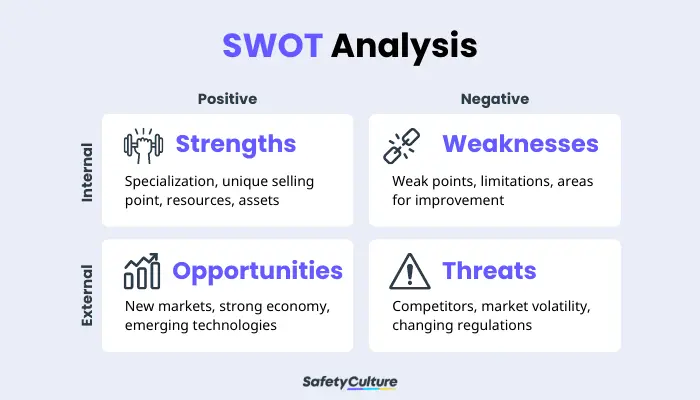What is Performance Benchmarking?
Performance benchmarking compares and analyzes an organization’s performance against industry standards or best practices. It helps organizations identify their strengths and weaknesses and opportunities for improvement.
Benchmarking can be done in various areas, such as financial performance, customer satisfaction, employee productivity and efficiency, and operational processes. It can also be done internally within an organization or externally with other organizations in the same industry or market. It can also be done on a one-time basis or as an ongoing process to improve performance continuously.
Benefits of Benchmarking Performance
The following are just a few of the benefits of doing performance benchmarking.
Improve Performance With an Independent Perspective
An external perspective is critical to performance benchmarking because realizing your business’s weaknesses can be difficult when you are too familiar with the business practices. By benchmarking your performance against others, you can identify best practices and strategies that have worked well for others and apply them to your business.
For example, suppose you’re benchmarking your customer service performance. In that case, you may find that other businesses in your industry use chatbots or other automated tools to provide faster and more efficient service. This information can help you improve customer service performance by implementing similar tools or processes.
Identify Specific Areas of Opportunity
Identifying specific areas of opportunity through benchmarking can also help you prioritize your improvement efforts and allocate resources more effectively. Rather than trying to improve every aspect of your organization, you can focus on the areas that will impact your overall performance and allocate your resources accordingly.
For example, if you are benchmarking your sales performance, you may discover that your sales team is not converting leads as effectively as your competitors. It could indicate a need for additional sales training or a shift in your sales strategy.
Validate Assumptions
False assumptions can be dangerous. For example, you might assume that your pricing strategy is competitive because you’ve always been successful in the past. However, if you benchmark your pricing against competitors, you might realize you’re charging too much or too little. This information can help you adjust your pricing strategy to be more competitive.
By validating assumptions through benchmarking, you can also identify areas where your company excels and leverage those strengths to gain a competitive advantage.
Set Expectations
When setting expectations, it’s essential to consider your industry, market, and competition. You can use industry benchmarks and best practices to set realistic goals and measure your performance against them.
Setting expectations also helps you communicate your goals and objectives to your team. By sharing your expectations, your team can align their efforts towards achieving those goals. It improves collaboration, productivity, and overall performance.
Another benefit of setting expectations is that it helps you make informed decisions. By measuring your performance against specific benchmarks, you can identify trends and patterns that inform your decision-making. It allows you to make data-driven decisions more likely to lead to success.
Monitor Performance and Manage Change
Monitoring performance can also help you stay ahead of the competition by identifying emerging trends and best practices in your industry. By benchmarking against top-performing businesses in your field, you can identify improvement opportunities and adopt new strategies to stay competitive.
In addition, benchmarking can help you manage change by clearly understanding how your business performs before and after implementing changes. By tracking performance metrics over time, you can measure the effectiveness of changes and make adjustments as needed to ensure continued success.
Types of Benchmarking
Different forms of benchmarking relate to particular aspects of a business. The most common types in manufacturing are performance, competitive, functional, and internal benchmarking. Below is an explanation of each:
Performance Benchmarking
Performance benchmarking is a method used to assess a company’s product with competitors and alternatives or within product families. It analyzes all aspects of production, including labor, machinery, and materials, as well as techniques and costs associated with the production and marketing of the product.
It also compares performance indicators to industry standards and competitors to identify strengths and weaknesses. The resulting insights are used to prioritize initiatives and investments.
Competitive Benchmarking
The goal of competitive benchmarking is to devise tactics to compete in a shared market and gain a competitive advantage. It may mean enhancing manufacturing efficiency, adapting to market needs, or adding new features. Defining the appropriate approach and distance to the objective can provide a competitive edge.
Functional Benchmarking
Functional benchmarking allows industries to analyze and implement successful practices from different industries that apply to shared functions, giving manufacturers a chance to gain insights from the experiences of others.
For example, several industries worldwide use Total Quality Management (TQM). This management framework, which began in the automotive industry in Japan, focuses on producing quality products and services to fulfill customer needs.
Internal Benchmarking
Internal benchmarking compares practices and performances within an organization. It looks at departments, product lines, or geographies with shared metrics or practices. It helps to understand the current standard of business performance.
Moreover, internal benchmarking aims not to create competition between departments but to encourage collaboration and learning. By sharing best practices and successful strategies, departments improve performance and contribute to the organization’s overall success.
The Steps to Successful Performance Benchmarking
Here are the steps you can take to conduct a successful performance benchmarking analysis:
Create a Plan
Defining the benchmarking exercise’s scope and objectives is the first step in doing a performance benchmark. It’ll help you to focus on the areas that are most important to your business and save time collecting data that isn’t relevant.
Next, identify the metrics that you want to measure. These may include financial metrics such as revenue and profit, operational metrics such as production efficiency, or customer metrics such as satisfaction levels.
Once you’ve identified the metrics, perform a SWOT analysis (Strengths, Weaknesses, Opportunities, and Threats) to see where your business is lacking or doing well.

SWOT Analysis
Additionally, senior management should participate in determining which processes are crucial to the organization’s success. You’ll also need their involvement to support any significant changes from your benchmarking, such as new product development, training, and purchasing new tools.
Conduct Research to Collect Relevant Data
After determining the appropriate metrics, discussions with employees, competitors, customers, and other relevant business stakeholders can commence. Engaging in one-on-one, focus group discussions or collecting survey responses can offer significant insights to guide your benchmarking process.
The data collected should be accurate, reliable, and relevant to the specific metrics or Key Performance Indicators (KPIs) you want to benchmark.
Analyze the Data to Determine Your Current Position and Desired Outcome
This step is crucial in identifying performance gaps and opportunities for improvement. As a result of your research, you will be able to determine your performance level compared to that of other companies or departments, and you will also be able to identify a reasonable and achievable goal for your improvement.
Data visualization tools (e.g., graphs or charts) will help your process. It’s way easier for people to understand images than pages of numbers. Plus, it can give you a holistic picture of any gaps in your performance and how far you’ll need to go to meet your desired benchmark.
Develop an Action Plan
In this implementation phase of the benchmarking process, you develop actionable steps for you and your stakeholders to achieve your goals. Creating a plan and defining success criteria can provide a clear direction for achieving goals and milestones.
One effective way to start is by utilizing established goal-setting methods such as SMART (Specific, Measurable, Actionable, Relevant, Time-Bound) and HEART (Habit-Forming, Emotional, Actionable, Realistic, Time-Bound).
Either approach can help you break down your big-picture benchmarking goals into smaller, more specific steps. For example, to improve customer satisfaction, you might aim to increase your customer satisfaction rating by 10 percent within the next six months.
Create Your Own Action Plan Template
Eliminate manual tasks and streamline your operations.
Get started for FREETrack Your Progress Regularly
Without tracking, you won’t know if you’re making progress or not. It’s like driving without a speedometer or a GPS—you won’t know how fast you’re going or if you’re on the right track. It’s important to track metrics consistently.
Regularly check your progress against defined goals for success. You can do it weekly, monthly, quarterly, or annually. If meeting benchmarks, continue the plan. If not, revise the plan and make corrections.




